
Precinct of Amon-Re
Encyclopedia


Luxor
Luxor is a city in Upper Egypt and the capital of Luxor Governorate. The population numbers 487,896 , with an area of approximately . As the site of the Ancient Egyptian city of Thebes, Luxor has frequently been characterized as the "world's greatest open air museum", as the ruins of the temple...
, Egypt
Egypt
Egypt , officially the Arab Republic of Egypt, Arabic: , is a country mainly in North Africa, with the Sinai Peninsula forming a land bridge in Southwest Asia. Egypt is thus a transcontinental country, and a major power in Africa, the Mediterranean Basin, the Middle East and the Muslim world...
, is one of the four main temple
Egyptian temple
Egyptian temples were built for the official worship of the gods and commemoration of pharaohs in Ancient Egypt and in regions under Egyptian control. These temples were seen as houses for the gods or kings to whom they were dedicated...
enclosures that make up the immense Karnak Temple Complex
Karnak
The Karnak Temple Complex—usually called Karnak—comprises a vast mix of decayed temples, chapels, pylons, and other buildings, notably the Great Temple of Amun and a massive structure begun by Pharaoh Ramses II . Sacred Lake is part of the site as well. It is located near Luxor, some...
. The precinct is by far the largest of these and the only one that is open to the general public. The temple complex is dedicated to the principal god of the Theban Triad
Theban Triad
The Theban Triad are three Egyptian gods that were the most popular in the area of Thebes, in Egypt.-History:The group consisted of Amun, his consort Mut and their son Khonsu. The eighteenth and twenty fifth dynasties of the New Kingdom favored the triad...
, Amun
Amun
Amun, reconstructed Egyptian Yamānu , was a god in Egyptian mythology who in the form of Amun-Ra became the focus of the most complex system of theology in Ancient Egypt...
, in the form of Amun-Re.
The site occupies roughly 250 000 m², containing many structures and monuments. Some parts of the complex are closed or semi-closed, partially large parts of the North/South Axis (VIII, IX, and X Pylon
Pylon (architecture)
Pylon is the Greek term for a monumental gateway of an Egyptian temple It consists of two tapering towers, each surmounted by a cornice, joined by a less elevated section which enclosed the entrance between them. The entrance was generally about half the height of the towers...
), as they are under active excavation or restoration. The whole southeast corner is semi-closed. The northwest corner is a museum that requires an additional ticket to visit.
Most of the southwest is an open-air-assembling area with millions of stone fragments, from small to huge, laid out in long rows, awaiting reassembly into their respective monuments. The area is not closed, as the temples of Khons and Opet both lie in this corner and are open to the public, though both are rarely visited considering the immense number of tourists coming to Karnak
Karnak
The Karnak Temple Complex—usually called Karnak—comprises a vast mix of decayed temples, chapels, pylons, and other buildings, notably the Great Temple of Amun and a massive structure begun by Pharaoh Ramses II . Sacred Lake is part of the site as well. It is located near Luxor, some...
. Also in this area can be found the housing of the Akhenaten Temple Project
Akhenaten Temple Project
The Akhenaten Temple Project is a project encompassing four archaeological expeditions to Egypt and north-east Africa. It has been in operation since 1972. The project is directed by Donald B...
, a sealed-up long building, which contains all the remains found of the dismantled Temple of Amenhotep IV
Temple of Amenhotep IV
The structures within the Temple of Amenhotep IV at Karnak in Luxor, Egypt, were used during the first four years of the reign of the Egyptian Pharaoh Akhenaten, when he still referred to himself as Amenhotep IV, although they may have been constructed at the end of the reign of Amenhotep III, and...
(Akhenaten
Akhenaten
Akhenaten also spelled Echnaton,Ikhnaton,and Khuenaten;meaning "living spirit of Aten") known before the fifth year of his reign as Amenhotep IV , was a Pharaoh of the Eighteenth dynasty of Egypt who ruled for 17 years and died perhaps in 1336 BC or 1334 BC...
).
History
The history of the KarnakKarnak
The Karnak Temple Complex—usually called Karnak—comprises a vast mix of decayed temples, chapels, pylons, and other buildings, notably the Great Temple of Amun and a massive structure begun by Pharaoh Ramses II . Sacred Lake is part of the site as well. It is located near Luxor, some...
complex is largely the history of Thebes
Thebes, Egypt
Thebes is the Greek name for a city in Ancient Egypt located about 800 km south of the Mediterranean, on the east bank of the river Nile within the modern city of Luxor. The Theban Necropolis is situated nearby on the west bank of the Nile.-History:...
. The city does not appear to have been of any significance before the Eleventh Dynasty
Eleventh dynasty of Egypt
The eleventh dynasty of ancient Egypt was one group of rulers, whose earlier members are grouped with the four preceding dynasties to form the First Intermediate Period, while the later members are considered part of the Middle Kingdom...
, and any temple building here would have been relatively small and unimportant, with any shrines being dedicated to the early god of Thebes, Montu
Mõntu
Mõntu is a village in Torgu Parish, Saare County in western Estonia....
. The earliest artifact found in the area of the temple is a small, eight-sided column from the Eleventh Dynasty, which mentions Amun-Re. The tomb of Intef II
Intef II
Intef II was a Pharaoh of the Eleventh dynasty during the First Intermediate Period. His capital was located at Thebes. At this time, Egypt was split between several local dynasties. After the death of the nomarch Ankhtifi, Intef II was able to unite all the southern nomes down to the First Cataract...
mentions a 'house of Amun', which implies some structure, whether a shrine or a small temple is unknown. The ancient name for Karnak, Ipet-Sut (usually translated as 'most select of places') only really refers to the central core structures of the Precinct of Amun-Re, and was in use as early as the 11th Dynasty, again implying the presence of some form of temple before the Middle Kingdom expansion.
East/West axis

.jpg)

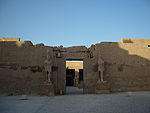
.jpg)
Cult Terrace
The modern entrance is placed over the end of the ancient cult terrace (or tribuneTribune (architecture)
Tribune is an ambiguous — and often misused — architectural term which can have several meanings. Today it most often refers to a dais or stage-like platform, or — in a vaguer sense — any place from which a speech can be prominently made.-Etymology:...
), causing most visitors to miss this significant feature. Inscribed into the terrace (though many are now eroded away) are the inundation levels for several kings of the Third Intermediate Period
Third Intermediate Period of Egypt
The Third Intermediate Period refers to the time in Ancient Egypt from the death of Pharaoh Ramesses XI in 1070 BC to the foundation of the Twenty-Sixth Dynasty by Psamtik I in 664 BC, following the expulsion of the Nubian rulers of the Twenty-Fifth Dynasty....
, collectively known as the Nile Level Texts
Nile Level Texts
The Nile Level Texts are inscribed on the cult terrace at the temple of Karnak, in Thebes, Egypt. This cult terrace itself was constructed during the time of Ramesses II, but the kings of the 22nd to the 26th Dynasties recorded the height of the Nile on its western side...
. The cult terrace is often mistakenly thought to be a dock or quay, but other examples, such as the one at the Hathor
Hathor
Hathor , is an Ancient Egyptian goddess who personified the principles of love, beauty, music, motherhood and joy. She was one of the most important and popular deities throughout the history of Ancient Egypt...
temple at Deir al-Madinah
Deir al-Madinah
Deir el-Medina is an ancient Egyptian village which was home to the artisans who worked on the tombs in the Valley of the Kings during the 18th to 20th dynasties of the New Kingdom period The settlement's ancient name was "Set Maat" , and the workmen who lived there were called “Servants in the...
, do not have access to water. It was intended for the presentation of cult images.
Corridor of Sphinxes
Originally the quay led via a corridor of Sphinxes to the entrance to the second pylonPylon (architecture)
Pylon is the Greek term for a monumental gateway of an Egyptian temple It consists of two tapering towers, each surmounted by a cornice, joined by a less elevated section which enclosed the entrance between them. The entrance was generally about half the height of the towers...
, but these were moved aside when the First Pylon was constructed.
First Pylon
Construction of the current pylon began in 30th dynastyThirtieth dynasty of Egypt
The Thirtieth Dynasty of ancient Egypt followed Nectanebo I's deposition of Nefaarud II, the son of Hakor. This dynasty is often considered part of the Late Period....
, but was never totally completed. It is 113 m wide and 15 m thick. There are large numbers of mud bricks piled up against the inside of the pylon, and these give a clue as to how it was constructed.
Forecourt
The construction of the original first pylon and Forecourt in the 22nd dynastyTwenty-second dynasty of Egypt
The Twenty-First, Twenty-Second, Twenty-Third, Twenty-Fourth and Twenty-Fifth Dynasties of ancient Egypt are often combined under the group title, Third Intermediate Period.-Rulers:...
enclosed several older structures, and meant that the original avenue of sphinxes had to be moved.
Boat Shrines
These were built in the time of Seti IISeti II
Seti II , was the fifth ruler of the Nineteenth dynasty of Egypt and reigned from 1203 BC to 1197 BC. His throne name, Userkheperure Setepenre, meant "Powerful are the Manifestations of Re, Chosen by Re.' He was the son of Merneptah and wife Isisnofret and sat on the throne during a...
, and are dedicated to Amun
Amun
Amun, reconstructed Egyptian Yamānu , was a god in Egyptian mythology who in the form of Amun-Ra became the focus of the most complex system of theology in Ancient Egypt...
, Mut
Mut
Mut, which meant mother in the ancient Egyptian language, was an ancient Egyptian mother goddess with multiple aspects that changed over the thousands of years of the culture. Alternative spellings are Maut and Mout. She was considered a primal deity, associated with the waters from which...
, and Khonsu.
Kiosk of Taharqa
In order to construct this kiosk, the ram-sphinx corridor was removed and the statues moved to the edges of the open court. Only one column remains in place, bearing inscriptions by TaharqaTaharqa
Taharqa was a pharaoh of the Ancient Egyptian 25th dynasty and king of the Kingdom of Kush, which was located in Northern Sudan.Taharqa was the son of Piye, the Nubian king of Napata who had first conquered Egypt. Taharqa was also the cousin and successor of Shebitku. The successful campaigns of...
, Psamtik II and Ptolemy IV Philopator
Ptolemy IV Philopator
Ptolemy IV Philopator , son of Ptolemy III and Berenice II of Egypt was the fourth Pharaoh of Ptolemaic Egypt...
.
Temple of Ramesses III
On the south side of the forecourt, there is a small temple built by Ramesses IIIRamesses III
Usimare Ramesses III was the second Pharaoh of the Twentieth Dynasty and is considered to be the last great New Kingdom king to wield any substantial authority over Egypt. He was the son of Setnakhte and Queen Tiy-Merenese. Ramesses III is believed to have reigned from March 1186 to April 1155 BCE...
. Inscriptions inside the temple show the king slaughtering captives, whilst Amun-Re looks on.
Bubastis Portal
This portal allows exit from the first court to the area to the south of the Temple of Ramesses III. It records the conquests and military campaigns in Syria-Palestine of Shoshenq IShoshenq I
Hedjkheperre Setepenre Shoshenq I , , also known as Sheshonk or Sheshonq I , was a Meshwesh Berber king of Egypt—of Libyan ancestry—and the founder of the Twenty-second Dynasty...
, of the Twenty-second Dynasty
Twenty-second dynasty of Egypt
The Twenty-First, Twenty-Second, Twenty-Third, Twenty-Fourth and Twenty-Fifth Dynasties of ancient Egypt are often combined under the group title, Third Intermediate Period.-Rulers:...
.
Second Pylon
This pylon was built by Horemheb near the end of his reign and only partly decorated by him. Ramesses I usurped Horemheb's reliefs and inscriptions on the pylon and added his own to them. These were later usurped by Ramesses II. The east (rear) face of the pylon became the west wall of the newly built Great Hypostyle Hall under Seti I who added some honorary images of the late Ramesses I to compensate for having had to erase his father's images there when he built the hall.Horemheb filled the interior of the pylon towers with thousands of recycled blocks from dismantled monuments of his predecessors, especially Talatat blocks from the monuments of Akhenaten along with a temple of Tutankhamen and Ay.
The Second Pylon's roof collapsed in late antiquity and was later restored in Ptolemaic
Ptolemaic dynasty
The Ptolemaic dynasty, was a Macedonian Greek royal family which ruled the Ptolemaic Empire in Egypt during the Hellenistic period. Their rule lasted for 275 years, from 305 BC to 30 BC...
times.
Great Hypostyle Hall
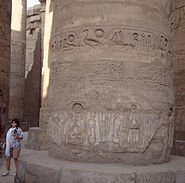
Seti I
Menmaatre Seti I was a Pharaoh of Ancient Egypt , the son of Ramesses I and Queen Sitre, and the father of Ramesses II...
, and completed by Ramesses II
Ramesses II
Ramesses II , referred to as Ramesses the Great, was the third Egyptian pharaoh of the Nineteenth dynasty. He is often regarded as the greatest, most celebrated, and most powerful pharaoh of the Egyptian Empire...
. The north side of the hall is decorated in raised relief, and was Seti I
Seti I
Menmaatre Seti I was a Pharaoh of Ancient Egypt , the son of Ramesses I and Queen Sitre, and the father of Ramesses II...
's work. He began to decorate the southern side of the hall shortly before he died but this section was largely completed by his son, Ramesses II
Ramesses II
Ramesses II , referred to as Ramesses the Great, was the third Egyptian pharaoh of the Nineteenth dynasty. He is often regarded as the greatest, most celebrated, and most powerful pharaoh of the Egyptian Empire...
. Ramesses decoration was at first in raised relief, but he quickly changed to sunk relief and then converted his raised relief decoration in the southern part of the hall, along with the few reliefs of Seti there, to sunk relief. He left Seti I's reliefs in the north wing as raised relief. Ramesses also changed Seti's names to his own along the main east-west axis of the Hall and along the northern part of the north-south processional route while respecting most of his father's reliefs elsewhere in the hall.
The outer walls depict scenes of battle, Seti I on the north and Ramesses II on the south. These scenes may not show actual combat, but could have a ritual purpose as well. Adjoining the southern wall of Ramesses II is another wall that contains the text of the peace treaty he signed with the Hittites
Hittites
The Hittites were a Bronze Age people of Anatolia.They established a kingdom centered at Hattusa in north-central Anatolia c. the 18th century BC. The Hittite empire reached its height c...
in the year 21 of his reign.
Third Pylon
Through the walls of the Hypostyle Hall is the mostly ruined Transverse Hall, alongside a reconstructed Third Pylon of Amenhotep IIIAmenhotep III
Amenhotep III also known as Amenhotep the Magnificent was the ninth pharaoh of the Eighteenth dynasty. According to different authors, he ruled Egypt from June 1386 to 1349 BC or June 1388 BC to December 1351 BC/1350 BC after his father Thutmose IV died...
. Though much ruined, in antiquity it was quite splendid and parts of it were even plated in gold by pharaoh Amenhotep III. A vestibule was added late in the pharaoh's reign and then partly decorated with incompleted triumph scenes by Amenhotep IV/Akhenaten before the new pharaoh abandoned the project due to his religious revolution which rejected the cult of the god Amun-Re.
In building the Third Pylon, Amenhotep dismantled a number of older monuments, including a small gateway he himself built earlier in the reign. He deposited hundreds of blocks from these monuments inside the pylon towers as fill. These were recovered by Egyptologists in the early 20th Century and led to the reconstruction of several lost monuments including the White Chapel of Senwseret I and the red chapel of Queen Hatshepsut which are now in the open air museum at Karnak.
The reliefs on the pylon were later restored by Tutankhamen who also inserted images of himself. These were, in turn, later erased by Horemheb. The erased images of Tutankhamen were long thought to be of Akhenaten himself, supposedly evidence of a coregency between Akhenaten and Amenhotep III, though most scholars now reject this.
Thutmose III & Hatshepsut's obelisks
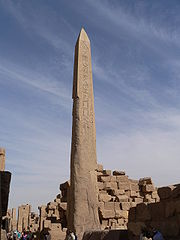
Obelisk
An obelisk is a tall, four-sided, narrow tapering monument which ends in a pyramid-like shape at the top, and is said to resemble a petrified ray of the sun-disk. A pair of obelisks usually stood in front of a pylon...
s, one which dates from Thutmose I
Thutmose I
Thutmose I was the third Pharaoh of the 18th dynasty of Egypt. He was given the throne after the death of the previous king Amenhotep I. During his reign, he campaigned deep into the Levant and Nubia, pushing the borders of Egypt further than ever before...
, and is 21.2 m high and weighs nearly 150 tons. Just beyond this is the remaining obelisk of Hatshepsut
Hatshepsut
Hatshepsut also Hatchepsut; meaning Foremost of Noble Ladies;1508–1458 BC) was the fifth pharaoh of the eighteenth dynasty of Ancient Egypt...
, nearly 30 m in height. Later kings blocked out the view of this from ground level, and constructed walls around it. Its companion lies, broken, by the sacred lake.
Sixth Pylon
The Sixth Pylon was built by Thutmose IIIThutmose III
Thutmose III was the sixth Pharaoh of the Eighteenth Dynasty. During the first twenty-two years of Thutmose's reign he was co-regent with his stepmother, Hatshepsut, who was named the pharaoh...
, and leads into a Hall of Records in which the king recorded his tributes. The pylon also includes some images of the god Amun which were restored by Tutankhamen after they were vandalized by Akhenaten. These images were later recarved by Horemheb who also usurped Tutankhamun's restoration inscriptions.
Sanctuary of Philip Arrhidaeus
The sanctuary was built in the time of Philip ArrhidaeusPhilip III of Macedon
Philip III Arrhidaeus was the king of Macedonia from after June 11, 323 BC until his death. He was a son of King Philip II of Macedonia by Philinna of Larissa, allegedly a Thessalian dancer, and a half-brother of Alexander the Great...
, on the site of the earlier sanctuary built by Thutmose III. This sanctuary contains blocks from the earlier sanctuary and older inscriptions can still be seen.
Middle Kingdom court
Only the base of three doors mark the entrances to the internal structures of this court.Festival Hall of Thutmose III
This stands to the east of the main temple complex. Between the sanctuary and the festival hall is an open space, and this is thought to be where the original Middle KingdomMiddle Kingdom of Egypt
The Middle Kingdom of Egypt is the period in the history of ancient Egypt stretching from the establishment of the Eleventh Dynasty to the end of the Fourteenth Dynasty, between 2055 BC and 1650 BC, although some writers include the Thirteenth and Fourteenth dynasties in the Second Intermediate...
shrines and temples were located, before their later dismantling.
The Festival Hall (or Akh-menu – "the most glorious of monuments") itself has its axis at right-angles to the main east-west axis of the temple. It was originally built to celebrate the jubilee (Hed-Sed
Sed festival
The Sed festival was an ancient Egyptian ceremony that celebrated the continued rule of a pharaoh...
) of Thutmose III, and later became used as part of the annual Opet Festival
Opet Festival
The Beautiful Feast of Opet was an Ancient Egyptian festival, celebrated annually in Thebes, during the New Kingdom period and later....
. In this temple, the Karnak king list
Karnak king list
The Karnak king list was located in the southwest corner of the Akh-Menu Hall. Composed during the reign of Thutmose III, it lists sixty-one kings beginning with Sneferu from Egypt's Old Kingdom...
, shows Thutmose III with some of the earlier kings that built parts of the temple complex. It contains the Botanical garden of Thutmosis III
Botanical garden of Thutmosis III
The Botanical garden of Thutmose III is an artistic representation, executed with a remarkable attention to detail, fauna and especially flora of the Egyptian empire at its peak. The reliefs are located on the walls of the room next to the Festival Hall of Thutmose III, in the Precinct of Amun-Re,...
.
North/South Axis
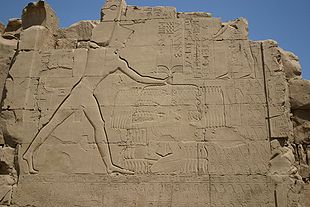
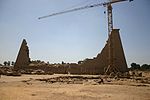
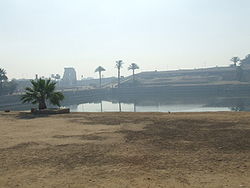
Precinct of Mut
The Precinct of Mut, located near Luxor, Egypt, is one of the four main temple enclosures that make up the immense Karnak Temple Complex and occupies some 150,000 m². It is dedicated to the Egyptian goddess Mut, the mother goddess. The area in which the precinct is located, originally was known as...
. Most of this area is off limits to tourists, as it is under active reconstruction and excavation.
First Court (Cachette Court)
Over 750 statues and 17,001 other artifacts were discovered in the early Nineteenth century buried under this open court. These had been buried there, probably in the PtolemaicPtolemaic dynasty
The Ptolemaic dynasty, was a Macedonian Greek royal family which ruled the Ptolemaic Empire in Egypt during the Hellenistic period. Their rule lasted for 275 years, from 305 BC to 30 BC...
period, during one of the clearances of the complex for rebuilding or construction. Excavations took place during a period of high waters, and were abandoned before the cache of artifacts were exhausted.
Seventh Pylon
On the southern side, there is a carving of Thutmose IIIThutmose III
Thutmose III was the sixth Pharaoh of the Eighteenth Dynasty. During the first twenty-two years of Thutmose's reign he was co-regent with his stepmother, Hatshepsut, who was named the pharaoh...
smiting Asiatic enemies, under which is a list of names of towns and peoples conquered in his campaigns in Syria-Palestine.
Second Court
Off to the eastern side of the court is an alabaster shrine, constructed for the jubilee of Thutmose III.Eighth Pylon
Constructed by HatshepsutHatshepsut
Hatshepsut also Hatchepsut; meaning Foremost of Noble Ladies;1508–1458 BC) was the fifth pharaoh of the eighteenth dynasty of Ancient Egypt...
, the seventh pylon marks the end of the area that is normally accessible to the public.
Ninth Pylon
This pylon was constructed (or at least completed) by HoremhebHoremheb
Horemheb was the last Pharaoh of the 18th Dynasty from either 1319 BC to late 1292 BC, or 1306 to late 1292 BC although he was not related to the preceding royal family and is believed to have been of common birth.Before he became pharaoh, Horemheb was the commander in chief...
. It is hollow and allows access to its top, via internal staircases.
Tenth Pylon
Again, it was Horemheb who built this last pylon, using the TalatatTalatat
Talatat are stone blocks of standardized size used during the reign of Akhenaton in the building of the Aton temples at Karnak and Akhetaten. The standardized size and their small weight made construction more efficient Their use may have begun in the second year of Akhenton's reign...
from the dismantled Temple of Amenhotep IV
Temple of Amenhotep IV
The structures within the Temple of Amenhotep IV at Karnak in Luxor, Egypt, were used during the first four years of the reign of the Egyptian Pharaoh Akhenaten, when he still referred to himself as Amenhotep IV, although they may have been constructed at the end of the reign of Amenhotep III, and...
as core building material. There are four registers of scenes around the gateway, in the name of Horemheb.
Other Structures
Located within the outer precincts of the complex are a number of other structures, some of which are accessible to the public.Sacred Lake
The sacred lake was where priests purified themselves before performing rituals in the temple. The sound and light show is now viewed from a seating area next to the lake.Temple of Ptah
This small temple lies to the north of the main Amun temple, just within the boundary wall. The building was erected by Thutmose IIIThutmose III
Thutmose III was the sixth Pharaoh of the Eighteenth Dynasty. During the first twenty-two years of Thutmose's reign he was co-regent with his stepmother, Hatshepsut, who was named the pharaoh...
, on the site of an earlier Middle Kingdom temple. The building was later enlarged by the Ptolemies
Ptolemaic dynasty
The Ptolemaic dynasty, was a Macedonian Greek royal family which ruled the Ptolemaic Empire in Egypt during the Hellenistic period. Their rule lasted for 275 years, from 305 BC to 30 BC...
.
Temple of Ramesses II
Also known as the Temple of the Hearing Ear this temple is located to the east of the main complex, on the east-west alignment. It was built during the reign of Ramesses II.Temple of Khons
This temple is an example of an almost complete New KingdomNew Kingdom
The New Kingdom of Egypt, also referred to as the Egyptian Empire is the period in ancient Egyptian history between the 16th century BC and the 11th century BC, covering the Eighteenth, Nineteenth, and Twentieth Dynasties of Egypt....
temple, and was originally constructed by Ramesses III
Ramesses III
Usimare Ramesses III was the second Pharaoh of the Twentieth Dynasty and is considered to be the last great New Kingdom king to wield any substantial authority over Egypt. He was the son of Setnakhte and Queen Tiy-Merenese. Ramesses III is believed to have reigned from March 1186 to April 1155 BCE...
, on the site of an earlier temple (the construction seems to be mentioned in the Harris Papyrus).
Open Air Museum
Several of the pylons reused earlier structures in their core. In the Open Air Museum, located in the Northwest corner of the complex, there are reconstructions of some of these earlier structures, notable amongst them the Chapelle RougeChapelle Rouge
The Red Chapel of Hatshepsut or the Chapelle Rouge originally was constructed as a barque shrine during the reign of Hatshepsut. She was the fifth pharaoh of the eighteenth dynasty of Ancient Egypt and ruled from approximately 1479 to 1458 BC....
of Hatshepsut
Hatshepsut
Hatshepsut also Hatchepsut; meaning Foremost of Noble Ladies;1508–1458 BC) was the fifth pharaoh of the eighteenth dynasty of Ancient Egypt...
, and the White Chapel
White Chapel
For other uses, see Whitechapel Currently reconstructed in the Karnak Open Air Museum, the White Chapel of Senusret II, also referred to as the Jubilee Chapel of Senusret I, was built during the Middle Kingdom of Egypt...
of Senusret I
Senusret I
Senusret I was the second pharaoh of the Twelfth Dynasty of Egypt. He ruled from 1971 BC to 1926 BC, and was one of the most powerful kings of this Dynasty. He was the son of Amenemhat I and his wife Nefertitanen. His wife and sister was Neferu. She was also the mother of the successor Amenemhat II...
.
External links
Further reading
- Weigall, A.E.P. A Guide To The Antiquities of Upper Egypt, Methuen, London, 1910
- Strudwick, N & H Thebes in Egypt, Cornell University Press, Ithaca, New York, 1999
- Peter J. Brand, 'Secondary Restorations in the Post-Amarna Period.' Journal of the American Research Center in Egypt 36 (1999)

